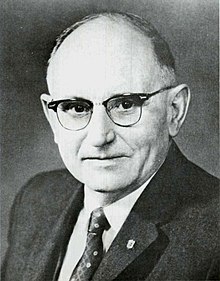Francis Higbee Case (December 9, 1896 – June 22, 1962) was an American journalist and politician who served for 25 years as a member of the United States Congress from South Dakota. He was a Republican.
Francis Case | |
|---|---|
 | |
| United States Senator from South Dakota | |
| In office January 3, 1951 – June 22, 1962 | |
| Preceded by | Chan Gurney |
| Succeeded by | Joe Bottum |
| Member of the U.S. House of Representatives from South Dakota's 2nd district | |
| In office January 3, 1937 – January 3, 1951 | |
| Preceded by | Theodore B. Werner |
| Succeeded by | E. Y. Berry |
| Personal details | |
| Born | Francis Higbee Case December 9, 1896 Everly, Iowa, U.S. |
| Died | June 22, 1962 (aged 65) Bethesda, Maryland, U.S. |
| Political party | Republican |
| Spouse | Myrle Graves |
| Alma mater | Dakota Wesleyan University Northwestern University |
| Occupation | Journalist |
| Military service | |
| Branch/service | United States Marine Corps United States Army |
| Battles/wars | World War I |
Biography
editCase was born in Everly, Iowa, the son of Mary Ellen (née Grannis) and the Reverend Herbert Llywellen Case.[1] He moved with his parents to Sturgis, South Dakota, at the age of 13. After graduating from the public schools he attended Dakota Wesleyan University and Northwestern University graduating in 1920. During World War I he served in the United States Marine Corps, and subsequently he served in United States Army Reserve and the Marine Corps Reserve.
Immediately after finishing college, he began a 15-year career as a newspaper editor. Until 1922, he was the assistant editor of the Epworth Herald in Chicago. From 1922 to 1925 he was the telegraph writer and editorial writer for the Daily Journal in Rapid City, South Dakota. From 1925 to 1931 he was the editor and publisher of the Hot Springs Star in Hot Springs, South Dakota. Finally from 1931 until he entered Congress he was the editor and publisher of the Custer Chronicle in Custer, South Dakota.
U.S. House of Representatives (1937–1951)
editCase entered politics in 1934 when he ran for a seat in the United States House of Representatives but lost. In 1936, however, he was elected to the U.S. House and served in it for seven terms. Before the United States entered World War II, he was a moderate supporter of isolationism. In 1947–8, he served on the Herter Committee.[2] Case left the House in 1951 when he became a senator.
U.S. Senate (1951–1962)
editCase decided to run for the Senate in the 1950 election, and defeated the incumbent John Chandler Gurney in the Republican primary. In the general election, he easily defeated Democrat John A. Engel receiving 63% of the vote. In his first term in the Senate, he served as chairman of the United States Senate Committee on the District of Columbia from 1953 to 1955, and was a supporter of greater self-rule in the district. In 1954, he served on a committee to investigate censuring Senator Joseph McCarthy. Case was reelected to the Senate in 1956, in a very close race against Democrat Kenneth Holum, receiving 50.8% of the vote.
Case was known as a moderate senator whose main goals were to expand America's road and waterway infrastructure, particularly in South Dakota. Lake Francis Case, along the Missouri River, is named after him, as is a bridge on I-395 in Washington, D.C. Case voted in favor of the Civil Rights Acts of 1957 and 1960,[3][4] but did not vote on the 24th Amendment to the U.S. Constitution.[5]
In 1956, Case alleged that he had been offered a $2,500 campaign contribution dependent on his support for the Harris-Fulbright Natural Gas Bill which would deregulate the natural gas market. The scandal led to the veto of the bill by President Dwight D. Eisenhower.[6][7]
Case served in the Senate from 1951 until his death. He died of a heart attack at the Naval Hospital in Bethesda, Maryland, on June 22, 1962. His death occurred several months before the expiration of his second term in the Senate. He is buried at Black Hills National Cemetery in Sturgis.
Honors
edit- South Dakota Highway 44 over the Missouri River in South Dakota has been dedicated as the Francis Case Memorial Bridge, crossing the Lake Francis Case43°03′35″N 98°33′43″W / 43.059722°N 98.561944°W
See also
editReferences
edit- ^ Current Biography, 1946, H.W. Wilson Company,
- ^ "Final Report on Foreign Aid of the House Select Committee on Foreign Aid" (PDF). Marshall Foundation. May 1, 1948. Retrieved May 30, 2020.
- ^ "HR. 6127. CIVIL RIGHTS ACT OF 1957". GovTrack.us.
- ^ "HR. 8601. PASSAGE OF AMENDED BILL".
- ^ "S.J. RES. 29. APPROVAL OF RESOLUTION BANNING THE POLL TAX AS PREREQUISITE FOR VOTING IN FEDERAL ELECTIONS". GovTrack.us.
- ^ https://library.cqpress.com/cqalmanac/document.php?id=cqal56-1349449 [bare URL]
- ^ Caro, Robert (2002). "29. The Program with a Heart". Master of the Senate: The Years of Lyndon Johnson. New York: Alfred A. Knopf. ISBN 0-394-52836-0.
- United States Congress. "Francis Case (id: C000221)". Biographical Directory of the United States Congress. Retrieved on 2009-02-16
External links
edit- "Research Opportunities in the Francis H. Case Papers at Dakota Wesleyan University". Archived from the original on 2006-03-22.
- Francis Case at Find a Grave
- Francis Higbee Case at Political Graveyard